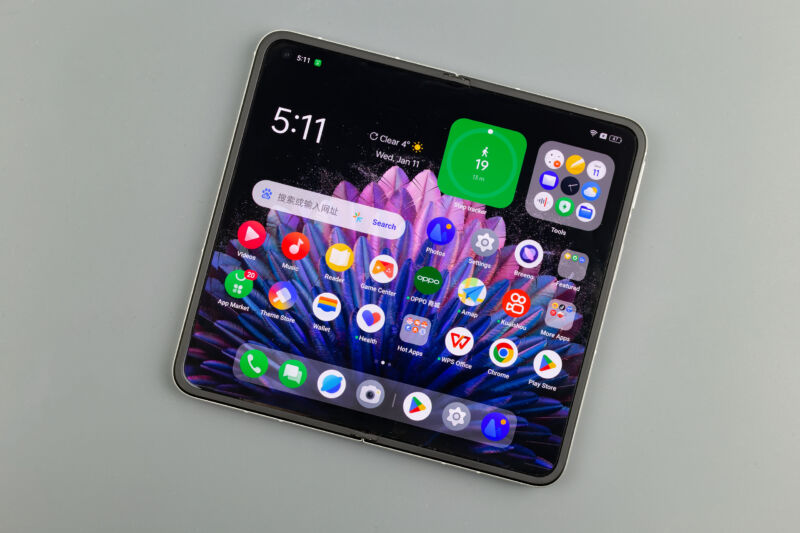
Ron Amadeo
One of the more interesting designs we’ve seen in the wild world of foldable smartphones comes from the Oppo Find N2. Its unique form factor and construction make it the lightest tablet-style foldable on the market, and it manages to have one of the least-noticeable creases of any foldable device.
While the phone is not shipping in the US, Oppo’s sub-brand OnePlus shares a lot of parts and software with the company, so we may see something similar here someday. But the limited distribution isn’t a huge loss, as Android is kind of a disaster on devices of this size. The device clearly needs to show something other than a phone UI on the big interior screen, but Android boots into a phone UI anyway. This means the bigger screen often presents a worse user experience because Android doesn’t know what to do with it.
The phone also reveals Android’s dark secret: Even if you dig into the developer settings and force everything to act as a tablet app, those apps don’t look good on foldables, either. Google’s tablet resurrection plans revolve around ultrawide 16:10 tablets, and those interfaces are cramped on the smaller square displays of foldables. Apps built for tablets are just not good enough for foldables.
Hardware
-
The front display of the Oppo Find N2.
Ron Amadeo -
The inner display of the Oppo Find N2.
Ron Amadeo -
There’s no crease. It’s more of a large trench running down the center of the phone.
Ron Amadeo -
The side. That’s a fingerprint reader in the power button.
Ron Amadeo -
The back.
Ron Amadeo -
The camera bump is curved. That’s good because you’ll be touching it a lot.
Ron Amadeo -
The spine.
Ron Amadeo -
The stand-up camera mode is fun.
Ron Amadeo
I have nothing but nice things to say about the Oppo Find N2’s hardware. At 132.2 mm tall, it’s as tall as an iPhone 13 Mini (131.5 mm), but it doesn’t feel small in the hand, as it’s still a normal width when folded up—72.6 mm. (A mini is 64.2 mm wide). The result is a stumpy little 18:9, 5.54-inch front screen, which feels like a throwback to an age before the super-tall 19.5:9 display. Screens were shorter back then because of thick top and bottom bezels, but this device pulls off a similar front-screen shape with bezels that are about as small as you could ask for.
The Find N2 is also super light for a foldable. Normally, we wouldn’t care too much about a phone’s weight, but some foldables get so heavy that they’re cumbersome to put in a pocket. A normal big phone weighs around 220–240 grams. Samsung’s highest weight on a foldable came on the Galaxy Z Fold 2, which was 282 g, while the Fold 4 is down to 263 g. The Oppo Find N2 weighs 233g—less than an iPhone 14 Pro Max. The reasonable weight helps the Find N2 feel like a normal phone instead of a giant brick.
| SPECS AT A GLANCE: Oppo Find N2 | |
|---|---|
| SCREEN | Exterior: 5.54-inch, 120 Hz, 2120×1080
Interior: 7.1-inch, 120 Hz, 1920×1792 |
| OS | Android 13 |
| CPU | Qualcomm Snapdragon 8+ Gen 1 |
| RAM | 12GB |
| STORAGE | 256GB |
| NETWORKING | Wi-Fi 6, Bluetooth 5.3, GPS, NFC |
| PORTS | USB Type-C |
| CAMERA | 50 MP main camera, 32 MP 2x telephoto, 48 MP wide-angle, 32 MP front |
| SIZE | Unfolded: 132.2 × 140.5 × 7.4 mm Folded: 132.2 × 72.6 × 14.6 mm |
| WEIGHT | 233 g |
| BATTERY | 4520 mAh, 67 W charging |
| STARTING PRICE | ~$1,137 (8,000 CNY) |
| OTHER PERKS | Side fingerprint reader |
It’s still the shape of a brick, though. The phone is officially listed at 14.6 mm when folded up, but that’s without the sizeable camera bump. With the bump included, the phone is 18 mm thick. We weren’t fans of the smartphone thinness wars of years past, but when a device is double the normal 8-mm thickness of a smartphone, thinness matters.
Xiaomi’s Mix Fold 2 and Huawei’s Mate X3 have been doing incredible work on foldable thinness—both manage to be just over 5 mm thick for each half and around 11–12mm folded up. The record goes to the (probably dead) Microsoft Surface Duo line, which is 9.9 mm when folded up.
Because the device is outrageously small, your index finger will regularly contact the camera bump while holding the phone. Having your fingers contact anything other than smooth, slippery glass helps with grip—the bump is like a little shelf to rest your index finger.
The display is similar to Samsung’s usual foldable loadout, with a flexible OLED display, a layer of ultra-thin glass, and then a top layer of protective, non-removable plastic. A plastic bezel running around the perimeter of the display makes Android’s default swipe-in gestures a pain to use, though—you’ll keep bumping into the raised bezel with your finger.
Just like a Moto Razr, the screen does away with the “crease” you typically see in Samsung devices, thanks to stowing the display in a teardrop shape when folded up. Around the fold area, collapsable supports behind the display can move out of the way when the device is closing so the display doesn’t get crushed.






